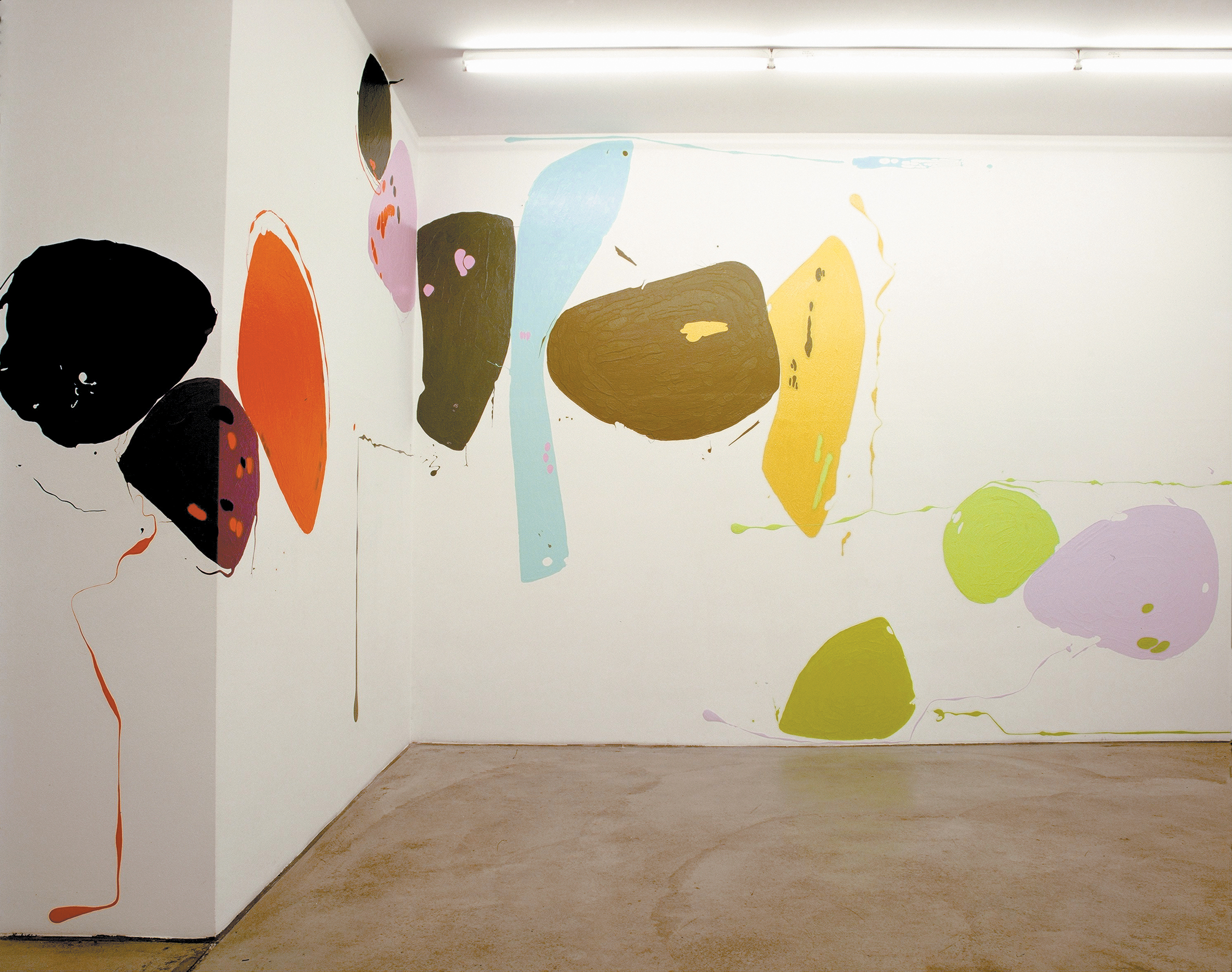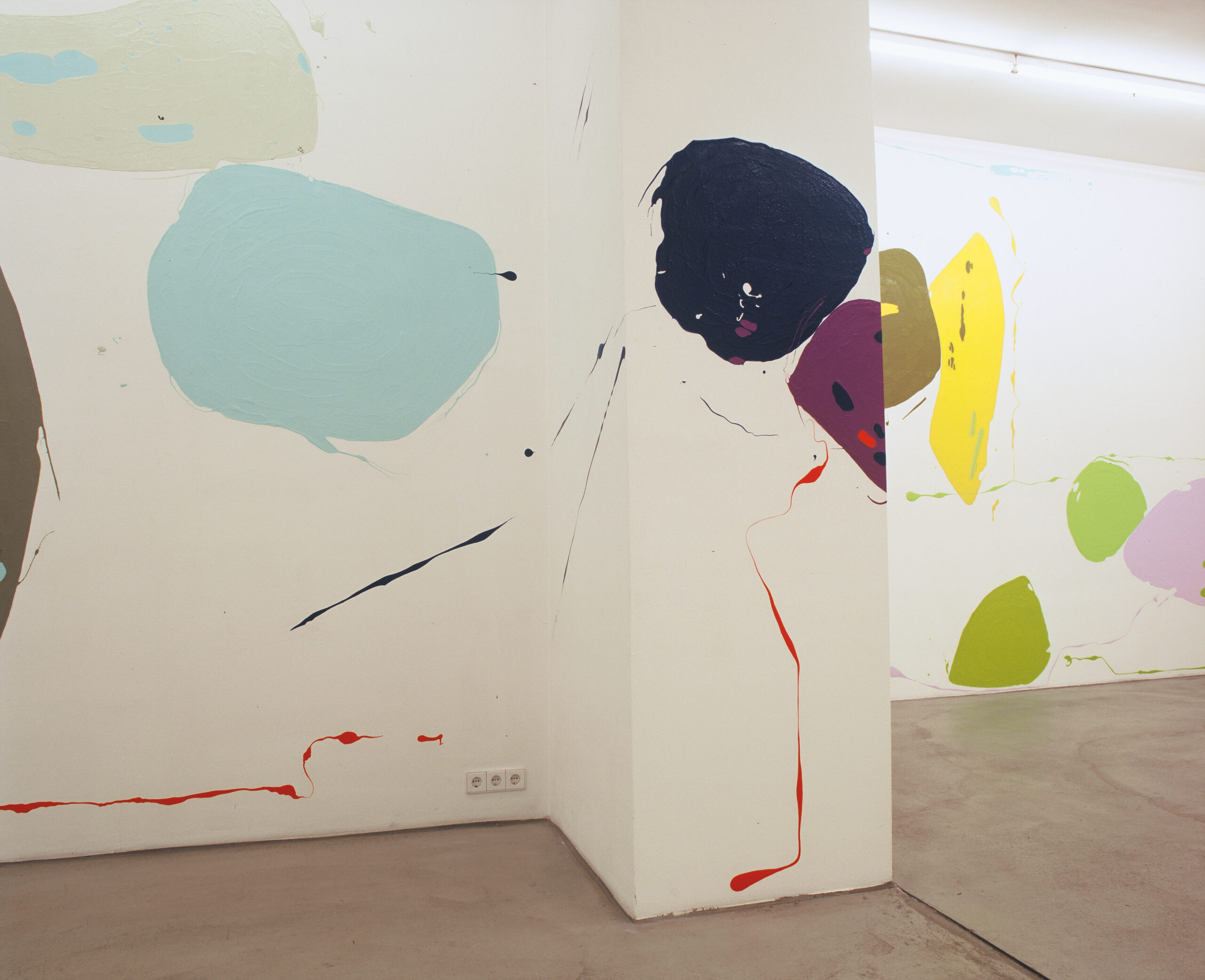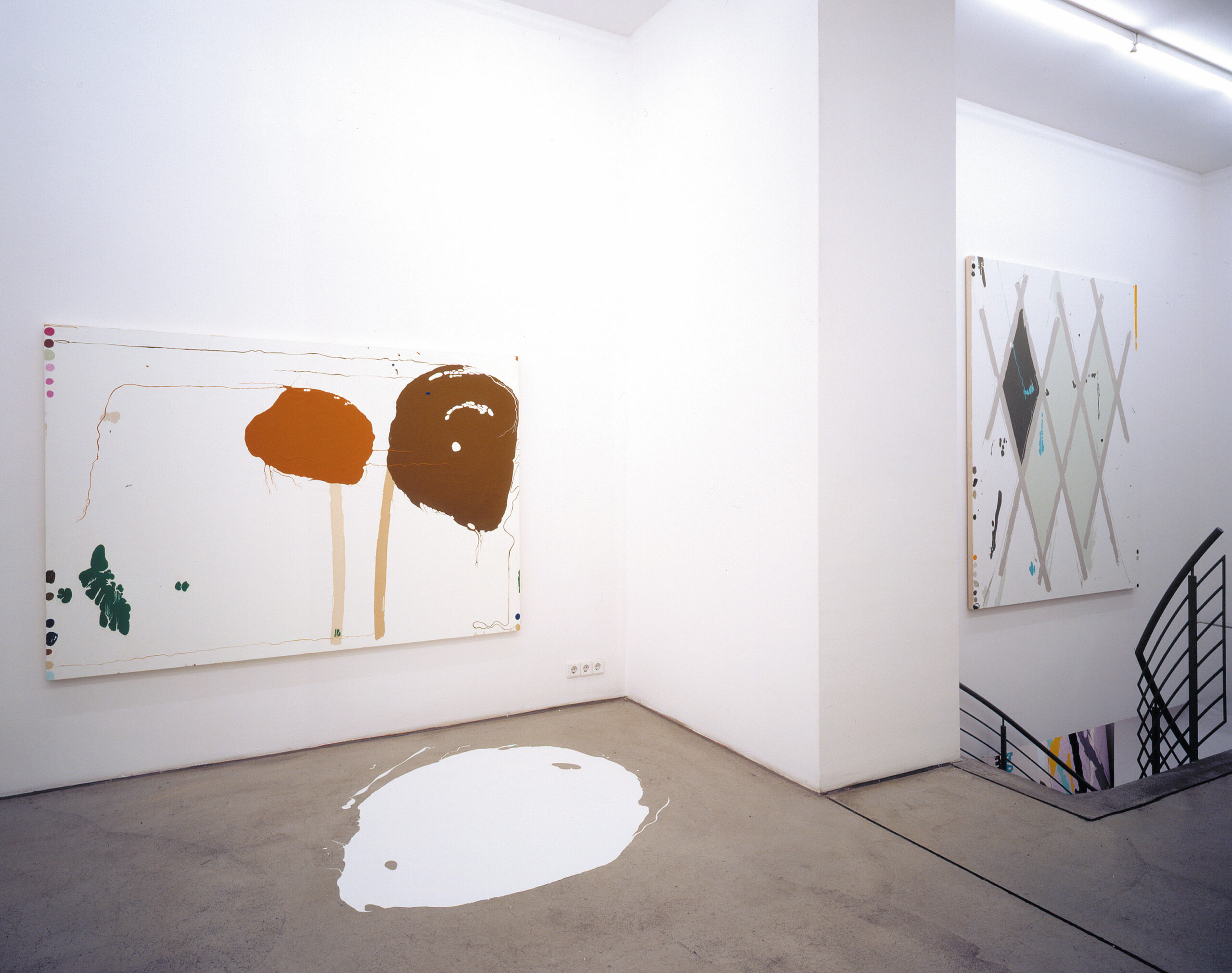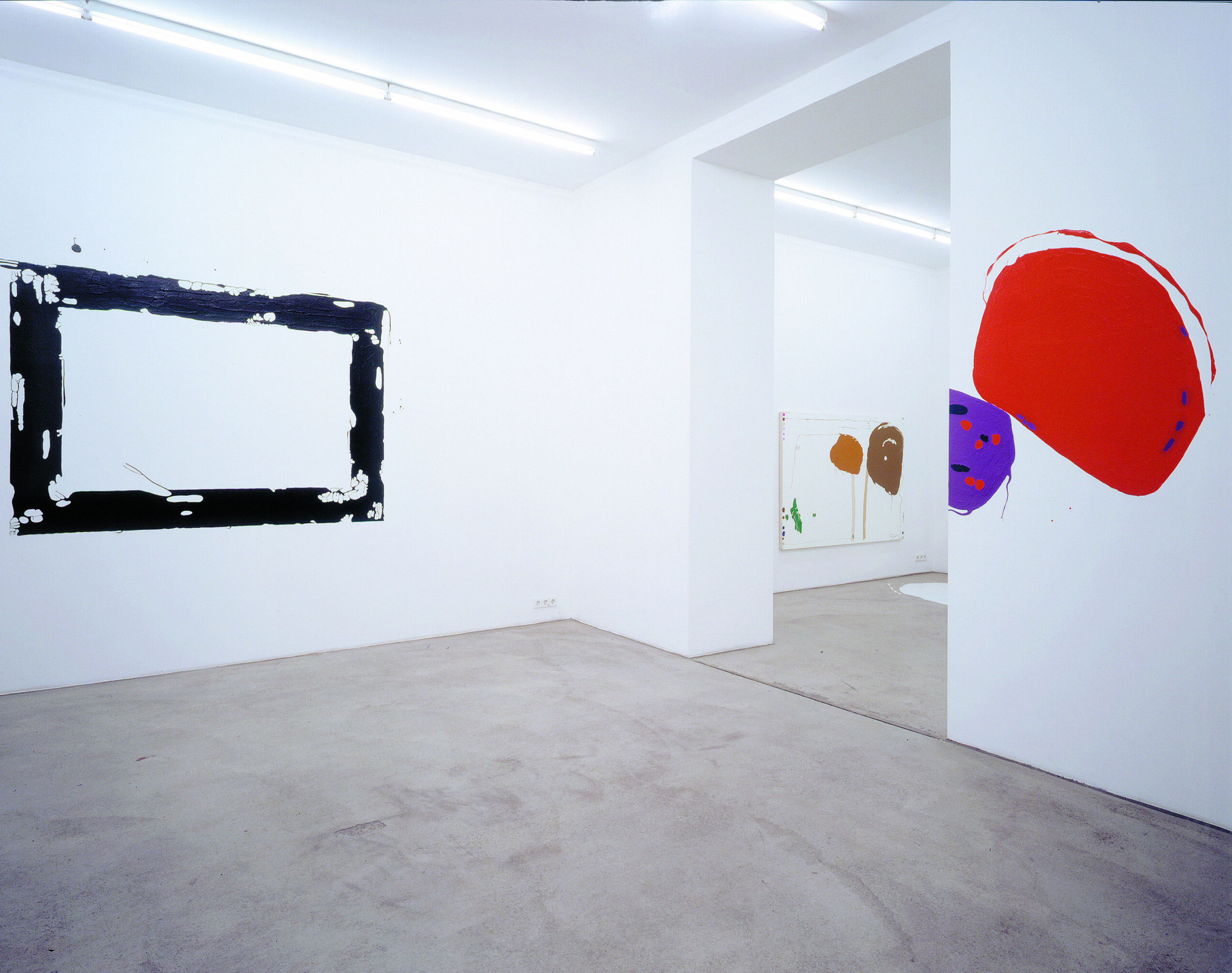
Instrumentell, veränderbar, abstrakt
Das Strahlen und Sprühen dieser Bilder, das an Kaleidoskope oder Feuerwerke denken lässt, steht am Ende eines Prozesses, in dem ein Bildkörper aufleuchtet, der zu Beginn – von seinen äußersten Rändern her – ebenso montiert wie demontiert worden war. Im strengen strukturellen Aufbau der Bilder, der seitenverkehrt angedacht und die einzelnen Schichten von vorne nach hinten auf einer Folie konzipiert, um sie erst in einem weiteren Arbeitsgang auf den Bildträger zu übertragen, muss also der spätere Flash, der zum Konzept des Aufbaus im scheinbaren Kontrast steht, einkalkuliert sein. Es mag ein Widerspruch sein, der gleichermaßen um das Verlassen des Bildträgers wie um die Dominanz, um die Selbständigkeit von Form und Farbe kreist. Es geht aber auch um den Transfer, der im weitesten Sinn an Verfahren aus der Drucktechnik gemahnt, bzw. um den Einsatz einer Referenz, in der der Körper enthalten ist: “Instrumentell, veränderbar und abstrakt” nannte Jonathan Crary jene visuellen Erfahrungen außerhalb der Camera obscura, die verhinderten, dass eine “‘reale Welt‘ Festigkeit und Dauer annehmen” könnte. Ein streng geregeltes Verhältnis zu Bild bzw. Apparat (zum Kaleidoskop etwa) ließ im Gegenzug eine neue Abstraktion und Mobilität zu
Das energetische Modell von Form bzw. Farben, die wie Siebdruckfarben bzw. industrielle Farben grell leuchten, besteht in einem Drängen an die äußerste Oberfläche, wo zentrifugale Kräfte große und bildbestimmende Formen das Bild mobil halten und das Zentrum, von dem die Bewegung ihren Ausgang haben könnte, den Bilduntergrund bzw. die Leinwand also, buchstäblich hinter sich lassen. Und trotz der Schwere mancher Formen ist ein Schwebezustand da, wenngleich die große Illusion von Motorik heftig auf den (statischen) Betrachter trifft. Auch einzelne Bildtitel greifen das Thema der Bewegung immer wieder auf, wenn es “every motion tends to describe a full circle”, “round reversion” oder “orange walk” heißt: Noch einmal wird deutlich, dass sich die Bilder bewegen, wir aber stillhalten.
Und ein Blick in das New Yorker Atelier, das eine Serie der dort 1999 entstandenen Bilder zeigt, erinnert auch noch einmal daran, dass Pop mit Knall übersetzt wird und dass “the shift from nature to culture”, wie Leo Steinberg Rauschenbergs Kunst beschrieb, immer wieder neue Felder erproben kann. Die dicken Farbschichten werden zu Schablonen bzw. zu undurchlässigen Folien, deren Eindruck einer quasi maschinellen Fertigung und Plastizität dennoch durch die vielen Schlieren, Kratzer und Spritzer unterlaufen wird. Sie sind indexalisch angelegte Spuren, die das Ikonische der großen Formen auffangen, um die sie Fäden und Netze spinnen. Wie ein Kommentar fliegen sie um die großen Zeichen bzw. können auch in sie eingebunden sein, können verklammern und verbinden. Das ist das Feuerwerk, das dem Ikonischen immer Spuren entlockt, die dann andere Kreise ziehen und schon zu Boden gefallen sind, wenn die große Bewegung noch andauert. Diese Fährten bewältigen jede Distanz, bis hin zu den Rändern, wo noch eine dritte Kategorie von Formen da ist: Die in einer Reihe angeordneten Farbpunkte sind ein weiteres Angebot an Information, wie Richtwerte für einen Drucker, Bedienungsanleitung für eine Maschine. Sie rufen aber auch die Palette des Malers in Erinnerung, die gegen das Maschinelle einer Farbskala aufgewogen werden kann. Die Maschine kann viele Bilder erzeugen. Der Erfinder des Kaleidoskops, Sir David Brewster, wollte die Kunst nach dem Vorbild der industriellen Produktion reformieren. In einer Stunde konnte es das liefern, was “tausend Künstler im Verlauf eines Jahres nicht erfinden könnten”. Neben einer beispiellosen Geschwindigkeit bot es Schönheit und Präzision. – In welchem Künstlichsein auch immer die Bildproduktion bzw. das Bild verortet ist, hat es nicht aufgehört, Modell bzw. ideale Norm zu sein. Die Entscheidung Barbara Mungenasts, nun, nach einer dichten Produktion von Bildern eine große Rauminstallation zu erproben, ist gewiss eine weitere logische Konsequenz, hier Grenzen auszutesten und die indexalische Situation des Randes zu überprüfen. Bestimmt aber wird die Farbe auch hier nicht Gestalt und Raum untergeordnet sein.
Instrumental, modifiable, and essentially abstract
There is a sparkling and beaming in these paintings such that one is reminded of kaleidoscopes or fireworks. At the same time, this marks the end of a process where a body of painting lights up, which –at the beginning- from its outermost edges was both being put together and taken apart.
This means that within the painting´ s rigid structures this future flash has to be taken into account. The flash itself is seemingly contradictive to the concept of composition, which is planned inversely and designed in reversed order on single layers of foil. It still takes another step for it to be transferred onto the canvas. It might be a contradiction that equally circles around the act of leaving whatever bears the painting and around the dominance, the self-sufficiency of form and color. Yet, it also deals with the transfer that in some remote sense hints at printing procedures, or in a general sense at the use of a reference in which the body is included.: ” Instrumental, modifiable and essentially abstract” was how J. Crary called those visual experiences outside the camera obscura that prevented a ” real world ” from acquiring ” solidity and permanence ”. A strictly organized relation to pictures resp. to an apparatus ( for instance to the kaleidoscope) allowed in turn for a new abstraction and mobility.
The energetic model of forms and colors that shine brightly like silk screen colors or industrial paint consists of an urge to approach the outermost surface. There, centrifugal forces and big forms determining the painting keep it mobile and literally leave the centre from which the movement could originate, that is the painting’s foundation, the canvas. In spite of the heaviness of some of the forms there is a state of floating even though the big illusion of motor activity hits the static viewer severely. Individual titles also frequently refer to the theme of movement, for instance ”every motion tends to describe a full circle”, ”round reversion” or ”orange walk”: Once again it becomes obvious that the paintings are moving whilst we remain motionless.
One look into the New York studio that shows a series of the paintings created here in 1999 serves a as another reminder of the fact, that pop means bang and that ” the shift from nature to culture” as Leo Steinberg described Rauschenberg´s art can always check out new areas. The thick layers of paint turn into templates resp. impermeable foil. Their impression of a seemingly industrial making and plasticity is still undermined by many streaks, scratches and splashes. They are indexically adjusted traces, that capture the iconic character of the big forms around which they weave/spin threats and nets. Like a comment they fly around the big signs resp. they can also be woven into them, connecting them and locking them together. This is the firework that continuously extracts traces out of the iconicity. These again draw other circles and have already dropped to the ground while the big movement is still going on. These trails cover any distance, up to the edges, where there is a third category of form: the color spots, arranged in a row, are another offer of information like a guide number for a printer, an operating instruction for a machine. They also call into mind the palette of a painter, that can be held up against the machine-like character of a color-range. The machine can produce many pictures. The inventor of the kaleidoscope- Sir David Brewster- wanted to reform art after the model of industrial production. In one hour, it could produce, what ” a thousand artists could not invent within a year”. Apart from the unparalleled speed, it offered beauty and precision. In whatever kind of artificialness the production of the painting or the painting itself is located, it has not stopped being a model and the ideal norm. Barbara Mungenast´s decision to now try an installation after a ceaseless production of paintings, undoubtedly is another logical consequence, to check on boundaries and examine the indexical situation of the edge. Certainly, also in this case, color will not be subordinate to form and space.
– Susanne Neuburger



